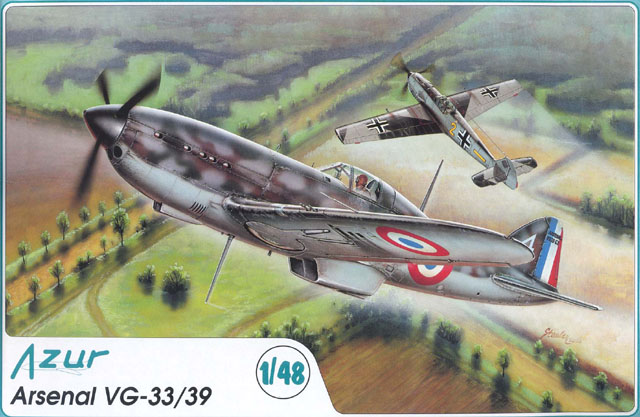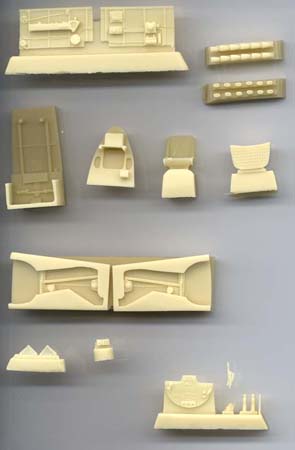|
Arsenal
VG-33/39

Azur
S
u m m a r y
|
| Catalogue
Number: |
Kit No.018 |
| Scale: |
1/48 |
| Contents and Media: |
2 sprues in "limited
run" injected plastic, 31 resin parts, 1 sheet of decals, 2
x vacform canopies. |
| Price: |
USD$20.96 from Squadron.com |
| Review Type: |
FirstLook |
| Advantages: |
Nicely cast resin parts;
finely engraved wing and fuselage detail; unusual subject. |
| Disadvantages: |
Some small areas of flash
and no locating pins on parts. |
| Recommendation: |
Recommended to more
experienced modellers due to the parts fitting requirements and
the multi-media nature of the kit. Additional skills needed if
modelling the VG 39 version. |
Reviewed
by Dale Smith
The French Arsenal VG series of aircraft were named for
Ingenieur-General Vernisse (V - director) and Jean Gaultier (G
- designer). This series of aircraft started life with the VG-30 fighter
proposal in the mid 1930's.
Designed to compete in the lightweight interceptor requirement
against the Caudron c.713, it was of all wooden, stressed skin
construction. The proposed powerplant was a Potez 12 Dc "flat
twelve" air cooled engine rated at 610 hp. Due to delays in the
development of that engine, the first prototype was actually flown in
October 1938 equipped with by a Hispano-Suiza 12 Xcrs 12 cylinder liquid
cooled engine of 690 hp.
The VG-31 and 32 aircraft followed with design changes and the use of
differing engines. The VG-32 was powered by an Allison V-1710-C15 engine
but was captured 2 weeks before its maiden flight by the Germans at
Villacoublay in 1940.
VG-33 aircraft development was started in
May, 1939 and with exceptional performance, an order for 220 aircraft
(later increased to 1000 aircraft) was placed in September, 1939.
However only 19 examples were completed by the time of the French
collapse. Engine was the Hispano-Suiza 12Y31 engine developing 860
hp.
Armament consisted of a 20-mm Hispano-Suiza 404 cannon firing through
the propeller hub, and 4 wing mounted 7.5 mm MAC 1934 M 39 machine
guns.
The VG-39 was the final development of the
VG-30 series of aircraft. The main difference from the earlier VG-33 was
that it was powered by a Hispano-Suiza Type 89ter 12 cylinder liquid
cooled engine with an elongated propeller shaft producing 1,200 plus hp.
Additional design changes included the use of a revised wing structure
that retained the profiles and contours of the earlier VG-33 wing, and
the fitting of six 7.5 mm MAC 1934 M 39 machine guns. Despite this
specification, the picture I was able to locate of a VG-39 shows only
four wing mounted 7.5 mm machine guns.
The planned production model, the VG-39bis was expected to have a
fuselage from the VG-36 development aircraft, fitted with a 20mm
engine-mounted cannon and powered by a Hispano-Suiza 12Z engine of 1,600
hp. Performance was impressive, attaining 625 kph (388 mph) at 5,750 m
(18,865 ft).
Final production figures differed from reference to reference, but
being conservative, it would be fairly safe to say that production
before the surrender (not including proto-types) had amounted to roughly
100 to 160 airframes of the VG-33 version. 10 aircraft were able to
escape to the south of the country during the German invasion, but all
other aircraft were destroyed by the Germans after testing.
It appears only one (1) VG-39 spec. airframe was completed and test
flown before the surrender.
My main reference used was 'The Complete Book of Fighters' by William
Green and Gordon Swanborough.( Excellent.!!)
This Azur 1/48 scale kit enables either a VG-33
or VG-39 aircraft to be modelled.
Tooled and molded in the Czech Republic, the
molds, plastic, instructions and boxing appears very similar to an MPM
kit. It doesn't state anywhere if that is the case, but they are
strikingly familiar.
Two sprues of 'limited production' plastic are
supplied. The finish on the plastic is very smooth and no sanding will
be required before assembly. All panel lines are finely engraved. There
is a small amount of flash on some parts but nothing to really worry
about (click the thumbnails below to
view the larger images of the plastic parts).


No location pins are supplied on any of the
parts. The wings and horizontal tailplanes simply butt join to the
fuselage and tail. A separate nose profile in 2 halves is supplied to
enable construction of the VG-39 aircraft.
Instructions are provided for the removal of
the VG-33 nose-cone. This simply requires cutting on a particular panel
line, then adding the substitute nose cone. Two styles of propeller
spinner are also supplied for the versions with and without the engine
mounted 20mm Hispano cannon.
 The
resin parts supplied are without any molding imperfections or air
bubbles and cover the cockpit floor, rear bulkhead, armour plate, seat
(with moulded belts), sidewalls, instrument panel and control stick. Two
styles of exhaust manifold are supplied as well as undercarriage bays,
radiator, cannon barrels and undercarriage swivel braces. Watch the
swivel braces as they are tiny, and one slip with the knife and they are
orbit city - history! The
resin parts supplied are without any molding imperfections or air
bubbles and cover the cockpit floor, rear bulkhead, armour plate, seat
(with moulded belts), sidewalls, instrument panel and control stick. Two
styles of exhaust manifold are supplied as well as undercarriage bays,
radiator, cannon barrels and undercarriage swivel braces. Watch the
swivel braces as they are tiny, and one slip with the knife and they are
orbit city - history!
Unfortunately, being such a fine casting, my
control stick was broken. It was probably broken in the packaging
process. The part was in the plastic bag, so a small amount of
super-glue will fix the problem.
Detail on some of the resin parts is
comprehensive, however the wheel wells and cockpit floor looked a little
spartan and will probably benefit from a few hydraulic lines to beef
things up. Your own choice though.
No reflector gunsight is supplied in the kit,
so the modeller will need to fabricate one if desired.
Markings are supplied for three aircraft - 2
VG-33 aircraft, one from the French Air Force and one in German markings
that was tested after capture, probably at Rechlin. The lone VG-39
aircraft at Toulouse in July , 1940 is also supplied. The decals are
printed by 'Propagteam' and are nice and thin with good colour density.
The only area of concern I could see was that the rudder tricolour
stripe markings are supplied as a square decal and will require trimming
to the rudder profile after application.

The canopy is supplied as a vacform part. Azur
supply a spare, so you get a second chance if you make a mistake. I was
able to locate photos of some aircraft parked with an open cockpit, so
personal choice will dictate this option. The canopy slides back on
rails towards the rear of the aircraft. The instructions in this area
show the aircraft spine radio antennae, sitting very close to the edge
of the canopy when closed. The boxtop art shows it further back on the
spine, so whether it folded down when the canopy opened or not, or the
boxtop artwork is wrong, is an area of conjecture (can anyone out there
enlighten us in this area?). The aircraft design had a folding belly
aerial, so perhaps this is the case on the upper aerial, in that it
folded down toward the tail when the canopy opened.
The colour schemes of all three aircraft are
the standard late 1930s early 1940s French three colour scheme of mid
grey blue, brown and khaki in a mottled upper pattern, with a light grey
blue undersurface. All painting instructions are called out during
construction, however no reference to a particular manufacturers paints
or any FS reference is given.
I'm very impressed with the quality of the kits that are sourced from
Europe and the erstwhile eastern bloc manufacturers these days.
The quality of the plastic, and the overall finish of these
"limited run" kits is improving all the time. The multi-media
nature of the kits makes them more appropriate for experienced
modellers, but if we get the newer members to the hobby started on these
type of kits, they will be all the better modellers for it. Perhaps us
older modellers have been spoilt by the mainstream manufacturers.
This release from 'Azur' is a nice choice for the French aircraft
modeller, and should build up to very nice replica to sit next to that
Tamiya D.520 you've got in the cupboard.
Highly Recommended.
Many thanks to 'Squadron Mail Order' for supplying the
review kit.

Azur's
Arsenal 1/48 scale VG-33/39 is available online from Squadron.com
Review Copyright © 2001 by Dale
Smith
Page Created 21 May, 2001
Last updated 22 July, 2003
Back to HyperScale
Main Page
Back to Reviews
Page
|
Home | What's
New | Features
| Gallery |
Reviews | Reference
| Forum
| Search